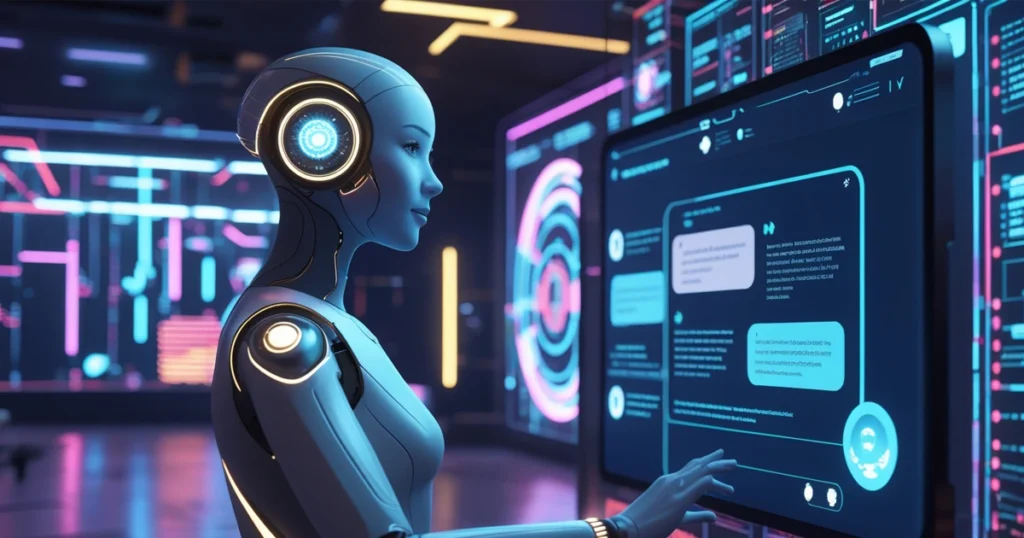AI Companions & Virtual Assistants: How to Build and Monetize AI-Powered Bots in 2025
Artificial intelligence continues to grow at a rapid pace among the more thrilling and influential innovations is the emergence of AI companions and virtual assistants. These advanced bots are able to change the way industries operate, transform customer experience, and provide personal support across a wide range of different applications. By 2025, AI-powered chatbots will be as widespread as smartphones. Their capability to help, engage and even monetize can create new opportunities for both businesses as well as developers.
In this post, we’ll look at the ways to create AI virtual assistants and companions and the most important technologies involved, as well as how to effectively monetize these bots. Let’s take a look at the realm of AI-powered bots and learn how you can make money from this growing market.
Understanding AI Companion as compared to. Virtual Assistants
Before we get into the details of developing and monetizing these bots it’s important to know the difference in AI associates as well as virtual assistants.
AI Companions
AI companions are built to replicate human-like interactions. They typically designed to offer emotional support, customized experiences, and even companionship. They employ advanced neural process of language (NLP) techniques to engage in conversations and respond to emotional signals and engage on meaningful exchanges. Contrary to conventional virtual assistants, AI friends are much more compassionate and often used in situations like:
- Help with Mental Health AI companions are able to be virtual therapists, offering emotional support and conversation focused on improving mental wellbeing.
- Personalized Conversations Bots that engage users in informal or lengthy discussions, offering friendship and social interaction particularly for people who feel lonely.
- Lifestyle Coaching as well as Motivational Assistance: AI companions can assist users in navigating difficult times, giving life tips and motivational speeches.
The most well-known models of AI companions are platforms such as Replika or Woebot which are popular for their apps to help with mental health.
Virtual Assistants
Virtual assistants on contrary are designed to be task-oriented, and to help users perform certain tasks. They are typically used for scheduling, productivity, and managing a variety of professional or personal tasks. Some examples include voice-controlled assistants like Siri, Google Assistant as well as Amazon Alexa. Virtual assistants could:
- Control Calendars and Reminders scheduling appointments, setting reminders and helping users organize their time.
- Control Home Smart Devices The control allows users the control of smart appliances like thermostats, lights and security systems.
- Respond to Questions Search engines as well as internal databases, to give quick answers to queries that are factual.
Although each of AI partners and virtual assistants make use of AI technology, the primary objectives differ. AI companions are focused on social engagement and emotional interactions, while virtual assistants tend to be more efficient and focused on goals.
Why 2025? The Evolution of AI Technology
In 2030, AI digital assistants, companions, and other virtual devices will be smarter as well as user-friendly and easy to access. A variety of advances in AI technology are causing this change which makes it easier than ever before to create and deploy these robots:
Natural Language Processing (NLP)
The technology that powers AI virtual assistants and companions are Natural Language Processing (NLP), a subfield of artificial intelligence that concentrates on helping machines understand the human voice and translate it into. In recent times, NLP has seen significant improvements with the advancement of massive modeling of language (LLMs) such as GPT-4 (and its successors) that can produce human-like texts, understand the context and participate in deeper conversations.
- Hugging Face is among the top platform for NLP models. It provides a range of pre-trained models, datasets and tools to create chat-based AI systems. (Check out Hugging Face)
- OpenAI‘s GPT-4 and later versions will be the most important players on the scene, enhancing conversational fluency as well as emotional intelligence. (Explore OpenAI to discover cutting-edge NLP tools)
Sentiment and Emotion AI
In to replicate human-like interaction, AI companions need to comprehend and react to emotions. Emotion AI is also referred to by the name of affective Computing can allow AI systems to identify the emotions of people, interpret them, and then simulate human emotions using face recognition, speech analysis and even text analysis.
- Affectiva Affectiva, the Emotion AI platform, uses deep learning and computer vision algorithms to recognize emotional expressions and facial expressions in audio and video files. (Learn more about Affectiva.)
- Microsoft’s Empower is a tool that enables developers to integrate emotion recognition into their AI systems. This makes virtual assistants and other companions more sympathetic and responsive. (Explore Microsoft’s Empower)
Multimodal Capabilities
A bright future for AI assistants is in the multimodal capabilities. They aren’t limited to voice or text. They incorporate multiple types that input data, including videos, images, and gestures, in order to create more rich and more engaging experiences. For instance an AI companion can analyze vocal tone and facial expressions to adjust its response accordingly.
- “HTML0” by OpenAI’s DALL*E is an multimodal AI tool that creates pictures from descriptions of text. These could be incorporated with AI companions to create more lively conversations. (Check it out on OpenAI’s DALL*E)
- NeMo from NVIDIA is a powerful multimodal framework created to boost the capability of conversations in AI systems. (Visit NVIDIA NeMo for more details)
Data and Training
Data is a key element in the creation of AI companions. These systems are based on massive quantities of data from conversations to comprehend human speech patterns as well as emotions and behavior. Training data should be inclusive and diverse to prevent bias. synthetic data generation is used to simulate uncommon or even edge cases that might not exist in real-world data.
- Google Cloud AI provides tools to train AI models with massive data sets and a powerful infrastructure. (Learn more about Google Cloud AI)
Building Your Own AI Companion or Virtual Assistant
Making the first AI personal assistant, or a virtual one for 2025 requires appropriate tools and technology and knowledge of the needs of your customers. This is a step-by-step guide for building the perfect AI bot:
Step 1: Define Your Purpose and Niche
Before you begin creating, you must decide the functions the AI bot is going to do. It could be a friend providing emotional support or will it function as a virtual assistant who manages the tasks and reminding you of them? There are a few things to consider, including:
- Identify the target audience who will gain value from your bot. Are they professionals in search of productivity tools or are they individuals looking for emotional assistance?
- Basic Features What functions can your bot provide? For instance mental health assistance scheduling appointments, for instance or voice-controlled smart house management.
- Personality What type of personality do you wish your AI to possess? Funny, formal, friendly or compassionate?

Step 2: Choose the Right Tech Stack
The tools you choose and technologies will be based on the features you wish to put into place. Here are a few recommended technologies:
- Programming languages: Python is the most used language used for AI development because of the numerous libraries and frameworks available. JavaScript is a great choice for developing virtual assistants that are web-based.
- NLP APIs as well as Frameworks Utilize frameworks such as Hugging Face or OpenAI GPT for the generation of language. Dialogflow developed by Google is a fantastic choice to build conversationsal agents. (Visit Dialogflow for more details)
- Cloud Platforms Cloud platforms such as Amazon Web Services (AWS) and Google Cloud provide the infrastructure required to expand the size of your AI bot and then deploy it to a wide public. (Explore AWS and Google Cloud)
Step 3: Design Conversational UX
Creating a positive user experience (UX) is essential for AI virtual assistants and companions. Your bot needs to appear natural and interactive. Here’s how to create an enjoyable conversational experience
- Leverage NLP models to generate responses that resemble human communication. Be sure the bot can manage different conversations as well as interruptions, transitions, and other topics.
- tone and personality Determine the tone of the bot’s replies. Be sure that it is in line with your brand’s identity and the goal of the bot.
- Multimodal interactions Think about using text, voice and images to increase the user’s engagement. This is particularly beneficial for AI companions designed to replicate empathy.
Step 4: Ensure Data Privacy and Security
As AI bots frequently gather sensitive information, ensuring privacy for users is crucial. Use best practices, such as:
- GDPR as well as CCPA Compliance Check the AI bot is in compliance with rules for data protection, particularly when it is collecting personal data.
- Data encryption Make sure all interactions between the user and bot are encrypted.
- Transparency: Make sure you know what data the bot is collecting and the way it is employed.
Monetizing AI Companions & Virtual Assistants
After you’ve created the AI bot, it’s now time to think about ways to earn money from it. Here are some ways to generate income from AI-powered bots
1. Subscription Models
A subscribing model can be an effective method to make money from AI companions. Pay customers a per-month or an annual fee for premium features like personal guidance, special content or more features.
- Replika offers a model of freemium which allows users to access basic functions for free, however they must pay for premium features such as advanced conversations and customizing options.
2. Freemium Model
The freemium model offers essential features at no cost, with charges for advanced functionalities. For instance, you can let users interact with the bot for free, but demand a fee for features like coaching sessions that are personalized or one-on-1 conversations.
3. Advertising
Virtual assistants, especially when they are free including ads is an effective way to monetize. Advertisements can be displayed in idle time or as an element of the assistant’s job like recommending items or services.
4. Affiliate Marketing
AI assistants can suggest and market third-party products or services, earning commissions on every sale. For instance an AI assistant that is focused on fitness can suggest fitness equipment and earn commissions on sales made by affiliates.
5. Licensing Technology
If you’ve developed a powerful AI Assistant or companion think about licensing your technology to other businesses. Many companies may wish to incorporate AI assistants in their own systems for customer support or service.
Challenges and Ethical Considerations
While developing and commercializing AI digital assistants, companions and other virtual devices can provide huge potential, there are a few issues and ethical concerns to consider:
- AI Bias: AI models may reflect biases that are present within their data for training. It is essential to train your models using diverse, balanced datasets in order to guarantee fair and impartial behaviour.
- Privacy: AI assistants often collect sensitive data, which makes it crucial to prioritize user privacy and adhere to the regulations on data protection.
- Transparency and trust The users must be able to be able to trust their AI bot. Being open about your capabilities as well as its limitations and use can help foster trust.

The Future of AI Companions & Virtual Assistants
In the year 2025 AI robots as well as virtual assistants are expected to become much more a part of our everyday lives. With the advancements in AI the machines will become more adept at comprehending and responding the human experience, which will make the technology more useful in providing mental health care, personalizing learning, and many other areas. As technology continues to advance, AI bots will play a larger part in shaping industries and enhancing our daily experience.
Conclusion
Making and monetizing AI partners and virtual assistants provides an chance to tap into a rapidly growing market with a huge potential. Through leveraging the latest AI technology, generating engaging user experiences and experimenting with different monetization strategies, both business and developers can be prepared for success for 2025, and even beyond.
Make use of the platforms and tools available in the present, including OpenAI, Hugging Face, and Google Cloud AI, to build your personal AI-powered assistant that will draw attention of users and generate income. Future of AI is promising and it’s only an issue of time before these virtual assistants and companions become a regular part of our lives.
for more visit Mavlluxury








